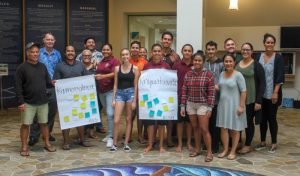IAU Adopts Hawaiian Names for Locally Discovered Asteroids

The collaboration between Hawaiian cultural practitioners, linguistic experts and youth from culturally-based educational environments is a groundbreaking new approach to formally naming astronomical discoveries. Courtesy photo
Maunakea Observatories and the ‘Imiloa Astronomy Center announced the official acceptance of Hawaiian names for two significant asteroid discoveries made by telescopes in Hawai‘i, according to a June 28, 2019, press release.
The names-Kamo’oalewa and Ka’epaoka’āwela-were selected by Hawaiian immersion students during the groundbreaking A Hua He Inoa pilot nomenclature project last year.
Their adoption by the International Astronomical Union (IAU) is a promising start to a future of indigenous celestial naming. These asteroids represent the second and third indigenous names accepted by the IAU following ‘Oumuauma, named in 2017.

Students, astronomers and mentors gathered at ‘Imiloa Astronomy Center for a two-day immersive experience to learn about the science, culture and history of astronomy in Hawai‘i. Courtesy photo
“Being able to be a part of, and experience, the connection between today’s science and our ancestral knowledge in the A Hua He Inoa program showed me the importance of learning about our culture and applying these lessons to our future,” said ‘Ālika Kuamo’o-Wilhelm, 2019 graduate of Ke Kula o Nāwahīokalani’ōpu’u.
“Naming asteroids using ‘Ōlelo Hawai‘i and Hawaiian traditions, and having those names recognized by the IAU, demonstrates that Hawaiian language has a significant place in modern science,” said Kelekolio Kuamo‘o-Wilhelm, 2019 graduate of Ke Kula o Nāwahīokalani‘ōpu‘u.
The A Hua He Inoa pilot program took place in October 2018. Leaders in astronomy and Hawaiian-medium education convened Hawai’i Island students, cultural practitioners and top research scientists to develop Hawaiian names for the two unusual celestial bodies:
Kamo‘oalewa is sourced from the kumulipo, and alludes to a celestial object that is oscillating, reflecting the asteroid’s path in the sky when viewed from Earth.
Ka‘epaoka’āwela means “the mischievous opposite-moving companion of Jupiter,” evoking the image of a retrograde object of unknown origin.

The names for the two objects were selected by the students and submitted to the International Astronomical Union for formal adoption. Courtesy photo
Following the IAU’s acceptance of ‘Oumuamua, for the icy comet and first interstellar visitor to our solar system detected by the Pan-STARRS 1 telescope on Haleakala, the official adoption of Kamo’oalewa and Ka’epaoka’āwela carries forward Hawai’i’s legacy of astronomical observation and celestial naming that dates back over a thousand years.
“It is exciting to see the Hawaiian language and cultural practices elevated on a global stage with the official recording of Kamo’oalewa and Ka’epaoka’āwela—not to mention the IAU’s consideration of Pōwehi for the incredible black hole discovery,” said Kaʻiu Kimura, ʻImiloa Astronomy Center executive director.
This year marks the International Year of Indigenous Languages, shedding greater light on the increasingly important role of native culture and traditional knowledge in modern contexts, including the advancement of science. Adding indigenous perspectives to modern science helps audiences understand global discoveries, making sense of what it means for them, their communities and beyond. It also provides a valuable connection between past and present that can inform the future. Expanding on their great work, A Hua He Inoa will be hosting a teacher summit to discuss how this achievement can be a driver of curriculum in schools throughout the state and inform a new way of approaching language, science, culture and collaboration.
About A Hua He Inoa
A Hua He Inoa is a collaborative effort lead by ʻImiloa Astronomy Center and the Maunakea Observatories. A Hua He Inoa creates pathways in which language and culture are at the core of modern scientific research, and is the first in the world to weave traditional indigenous practices into the process of officially naming astronomical discoveries.
About ‘Imiloa Astronomy Center
‘Imiloa Astronomy Center is an astronomy and culture education center located in Hilo, Hawai‘i, that advances the integration of science and indigenous culture. Their diverse exhibits, programs and events harness leading technologies, environmental resources and cultural practitioners to engage children, families and communities. ‘Imiloa is an integral part of the University of Hawai‘i at Hilo, committed to improving the quality of life of the people of Hawai‘i Island and state. Through partnerships with programs of the University, Hawai‘i-based observatories, local businesses and schools, ‘Imiloa creates opportunities that strengthen career awareness and workforce development, and contribute to the sustainability of Hawai‘i’s community.
Sponsored Content
Comments








